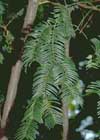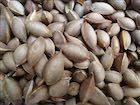Cephalotaxus fortunei
Hooker 1850
Common names
三尖杉 san jian shan [Chinese] (Fu et al. 1999), Chinese plum yew (Vidakovic 1991), three-pointed fir (literal translation of the Chinese name; Tripp 1995).
Taxonomic notes
Type: CHINA, Shaanxi, 200 miles N of Shang-see, no date, R. Fortune s.n. (holotype K!). Synonymy (POWO):
- Taxus fortunei (Hook.) C.Lawson ex P.Lawson et al. 1851;
- Cephalotaxus fortunei var. pendula Carrière 1855;
- Cephalotaxus kaempferi Anon. ex Garten-Nachr. 1858;
- Cephalotaxus robusta Rafarin ex Rev. Hort. (Paris) 1874; and
- Cephalotaxus fortunei var. concolor Franch. 1899.
Although Cephalotaxus fortunei has long been recognized as a distinct species, C. alpina was long treated as a variety, although it is now regarded as a good species in its own right. Sequencing of the complete chloroplast genome in Cephalotaxus finally clarified phylogenetic relationships (see Cephalotaxus) and revealed that C. fortunei is sister to a clade comprised of C. alpina and C. sinensis (Wang et al. 2022). Thus the two most widespread Chinese species of Cephalotaxus, C. fortunei and C. sinensis, are shown to also be very closely related. A molecular clock analysis by Ji et al. (2021) suggests that these taxa diverged from each other as recently as the late Pleistocene, about 60,000 years ago.
Description
Dioecious evergreen shrubs, or trees to 20 m tall and 30 cm (or more) dbh, usually multistemmed, with an open, loosely rounded crown. Bark dark reddish brown, peeling in strips. Twigs obovate, obtriangular or rectangular in cross-section; foliar units 4–21 × 3–20 cm, the leaves borne at 30–110° to branchlet axis on 0.5–2.0 mm petioles. Foliar buds small, covered with pointed, glossy, red-brown scale-like leaves which remain on the base of the shoot to the next year. Leaves deep green and glossy on adaxial (upper) surface, linear-lanceolate, distally gradually attenuate, falcate or ± straight, flat, 1.5–16.0 cm × 3.2–7.5 mm (longest in the genus), leathery but usually rather soft and flexible; abaxially the midvein 0.2–0.5 mm wide, flanked by stomatal bands 0.8–2.2 mm wide, usually with 13–24 rows of stomata, 2–5 × as wide as midvein; marginal bands 0.1–0.4 mm wide; leaf bases cuneate or short-attenuate, asymmetrical; margins flat or very narrowly revolute when dry; apices cuspidate, cusp 0.5–2.0 mm, often breaking off. Pollen cones borne in a 6-10 mm diameter globose head of 6–14 cones upon a 2–8 mm peduncle; bracts ovate, the largest ones ca. 2.0 × 2.5 mm, margin ± entire or erose, apex acute; microsporophylls 6–16, each with 3 or 4 pollen sacs. Seed cones borne 3–10 together, peduncle 3–12 mm; seed scales ca. 1.5 mm; aril yellow or green initially, turning purple when ripe, 14-25 × 9-15 mm, with numerous indistinct striations or prominent longitudinal ridges, apex very shortly mucronate. Seeds ellipsoid, 13–24 × 7–14 mm. Pollination
April–May, seeds maturing June–October. Chromosomes n = 11 (Vidakovic 1991, Tripp 1995, Fu et al. 1999, Lang et al. 2013).
Distribution and Ecology
N Myanmar and China: S Anhui, Chongqing, Fujian, Guangdong, Guangxi, Guizhou, S Henan, W Hubei, Hunan, Jiangxi, Shaanxi, Sichuan, Yunnan, Zhejiang (Fu et al. 1999, Lang et al. 2013). As such it is the most widespread species in the genus, found throughout warm temperate and subtropical China east of about longitude 102°. It grows at 200-3700 m elevation in mixed, coniferous, and broad-leaved forests, thickets, and roadsides (Fu et al. 1999); it is shade tolerant, and some provenances are hardy to Zone 7 (cold hardiness limit between -17.7°C and -12.2°C) (Bannister and Neuner 2001, Tripp 1995).
Distribution data (C. fortunei shown in yellow), based on GBIF occurrence download https://doi.org/10.15468/dl.bz6u39 (2024.08.24). Open left pane for legend; click on any icon for a link to source information. See map notes (left pane) for details on map preparation.
Some sources describe C. fortunei from Laos, but the latest authority finds C. mannii to be the only Cephalotaxus in Laos (Averyanov et al. 2014), and this is consistent with the known distribution and ecology of that species.
Rangewide, C. fortunei is classified as of "Least Concern" for conservation because it is a widespread and common species with no major identified threats, that regenerates well in secondary and disturbed forest (Hilton-Taylor et al. 2013).
Remarkable Specimens
I have no data on trees in habitat. Measurements for two specimens cultivated in Ireland include 77 cm dbh and 7.5 m tall for a tree in Tipperary, and 28 cm dbh and 11.0 m tall for a tree in Belvedere Gardens, Westmeath (Robert Van Pelt email 2024.09.03, reporting 2000 measurements).
Ethnobotany
Use as a source of timber is not recorded. The species is fairly common in horticulture; among Cephalotaxus, only C. harringtonia is more commonly seen. It grows into a large shrub or small tree with decorative foliage, and is often used in cases where pruning or hedge-trimming are desirable. Some individuals have good cold hardiness, but this likely depends much on provenance, given the wide range of the species. Several cultivars are known, and long-leaved forms seem to be especially popular. In China, oil extracted from the succulent aril enclosing the seed was traditionally used as lamp oil (Hilton-Taylor et al. 2013). A wide variety of novel organic chemicals have been isolated from the foliage, twigs, arils and seeds (Paudler et al. 1973, Zhu et al. 2021), some of which show promise as a basis for cancer treatments (e.g., Zhao et al. 2022).
Observations
I have no specific sites of interest, but the map shown above includes precise locations for known occurrences; iNaturalist will also be a useful resource for finding popular, easily-located occurrences.
Remarks
The epithet honors Robert Fortune, who collected it in China and introduced to Europe ca. 1849 and the U.S. ca. 1858 (Tripp 1995). Other conifers he introduced to Europe and the U.S. include Chamaecyparis funebris, Cryptomeria japonica, Keteleeria fortunei, Larix kaempferi, Pinus bungeana, and Thuja standishii.
Although all Cephalotaxus are dioecious like, some individuals have been known to change sex (Rushforth 1987).
Citations
Averyanov, Leonid V., Tien Hiep Nguyen, Khang Nguyen Sinh, The Van Pham, Vichith Lamxay, Somchanh Bounphanmy, Shengvilai Lorphengsy, Loc Ke Phan, Soulivanh Lanorsavanh, and Khamfa Chantthavongsa. 2014. Gymnosperms of Laos. Nordic Journal of Botany 32(6):765–805.
Hilton-Taylor, C., W. Liao, and Y. Yang, 2013. Cephalotaxus fortunei. The IUCN Red List of Threatened Species 2013: e.T42198A2960338. https://dx.doi.org/10.2305/IUCN.UK.2013-1.RLTS.T42198A2960338.en, 2024.08.20.
Hooker, W. J. 1850. Cephalotaxus fortuni. Curtis’s Botanical Magazine 6:t. 4499, p. 76.
Ji, Yunheng, Changkun Liu, Jacob B. Landis, Min Deng, and Jiahui Chen. 2021. Plastome phylogenomics of Cephalotaxus (Cephalotaxaceae) and allied genera. Annals of Botany 127(5): 697-708.
Lang, Xue-Dong, Jian-Rong Su, Shu-Gang Lu, and Zhi-Jun Zhang. 2013. A taxonomic revision of the genus Cephalotaxus (Taxaceae). Phytotaxa 84(1):1-24.
Paudler, William W., and Jerry McKay. 1973. Structures of some of the minor alkaloids of Cephalotaxus fortunei. The Journal of Organic Chemistry 38(11):2110-2112.
Wang, Jie, Chao-Nan Fu, Zhi-Qiong Mo, Michael Möller, Jun-Bo Yang, Zhi-Rong Zhang, De-Zhu Li, and Lian-Ming Gao. 2022. Testing the Complete Plastome for Species Discrimination, Cryptic Species Discovery and Phylogenetic Resolution in Cephalotaxus (Cephalotaxaceae). Frontiers in Plant Science 13: 768810. https://doi.org/10.3389/fpls.2022.768810, accessed 2024.08.26.
Zhao, Chun-Xue, Hui Liu, Xin Zhang, Meng-Yue Yang, Yue-Tong Wang, Yi-Jia Xing, Jun-Xin Hua et al. 2022. Cephalotaxine-type and homoerythrina-type alkaloids with antiproliferative effects from Cephalotaxus fortunei. Organic & Biomolecular Chemistry 20(35):7076-7084.
Zhu, Li, Li-Jie Gong, Dong-Rong Zhu, Jiang-Min Zhu, Yin Li, Ling-Yi Kong, and Jian-Guang Luo. 2021. Cephalotaxine-type alkaloids from the seeds of Cephalotaxus fortunei and their cytotoxic activities. Phytochemistry 191:112903.
See also
Elwes and Henry 1906-1913 at the Biodiversity Heritage Library. This series of volumes, privately printed, provides some of the most engaging descriptions of conifers ever published. Although they only treat species cultivated in the U.K. and Ireland, and the taxonomy is a bit dated, still these accounts are thorough, treating such topics as species description, range, varieties, exceptionally old or tall specimens, remarkable trees, and cultivation. Despite being over a century old, they are generally accurate, and are illustrated with some remarkable photographs and lithographs.
Threatened Conifers of the World.






